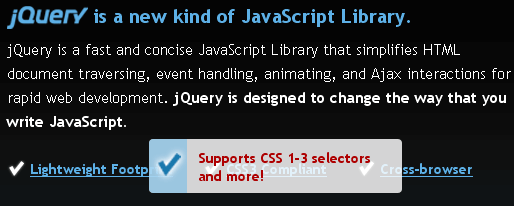Create a Custom “:checked” Pseudo Selector for MooTools 1.2
A few weeks back, I showed you how to create a custom ":selected" pseudo selector for use in MooTools. It was just a small snippet but I've found it incredibly useful, as has been the ":checked" pseudo selector I've been using.
The XHTML
<input type="checkbox" name="mycheckbox" value="1" checked="checked" />
<input type="radio" name="mycheckbox" value="1" checked />
Above are examples of checked elements.
The MooTools JavaScript
Selectors.Pseudo.checked = function(){
return ('input' == this.get('tag') && ('radio' == this.get('type') || 'checkbox' == this.get('type')) && this.checked);
};
Of course, you could always try to retrieve checked elements using "input[checked=checked]," but that code is case-sensitive and may not always return checked elements. What other pseudo selectors may be useful for MooTools?
![Welcome to My New Office]()
My first professional web development was at a small print shop where I sat in a windowless cubical all day. I suffered that boxed in environment for almost five years before I was able to find a remote job where I worked from home. The first...
![How I Stopped WordPress Comment Spam]()
I love almost every part of being a tech blogger: learning, preaching, bantering, researching. The one part about blogging that I absolutely loathe: dealing with SPAM comments. For the past two years, my blog has registered 8,000+ SPAM comments per day. PER DAY. Bloating my database...
![Duplicate the jQuery Homepage Tooltips Using MooTools]()
The jQuery homepage has a pretty suave tooltip-like effect as seen below:
Here's how to accomplish this same effect using MooTools.
The XHTML
The above XHTML was taken directly from the jQuery homepage -- no changes.
The CSS
The above CSS has been slightly modified to match the CSS rules already...
![HTML5’s window.postMessage API]()
One of the little known HTML5 APIs is the window.postMessage API. window.postMessage allows for sending data messages between two windows/frames across domains. Essentially window.postMessage acts as cross-domain AJAX without the server shims. Let's take a look at how window.postMessage works and how you...





One time I needed an empty value selector for input elements:
Selectors.Pseudo.novalue = function(){ return (this.tagName.toLowerCase() == 'input' && this.value === ''); };Or is there a way to test an empty attribute with CSS-Selectors, something like “input[value=]”? That didn’t worked in my case.
@thomasd: I like your “novalue” pseudo selector. As for your question, try this:
input[value=”]
David, your blog is the best, ever!
I love your articles, and I always use your tips.
hugs
@david: input[value=”] doesn’t work.
But the pseudo selector works quite well.
I really love mootools and the way it works!
Just a note though, :checked is already in Mootools Selectors source. http://tr.im/1n83
@Lim Chee Aun: Cool! It’s not in 1.2 so this must be new.
I know this entry is a tad old but I was wondering if this was tested in IE8? I’m using it in a project and in the one place I use this selector IE8 has fits. Problem is I can’t see anything there that would cause it….
Your thoughts??
Jon